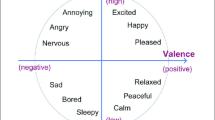Abstract
In this paper, we have developed a color block play device for children’s attention testing and validated it through correlation analysis with Mr. CUCUI testing, which uses currently for children’s attention testing. The developed device detects seven colors of objects using Arduino Uno, which receives data from the color sensor and uses a Bluetooth module to transmit that data to a smartphone wirelessly. In addition, we have developed a smartphone application that generates the order of stacking the block with voice. To evaluate the developed color block play device, we analyzed the correlation with the Mr. CUCUI test to verify the feasibility. The correlation result shows a high correlation of -.783. This result means that the color block test is valid as an attention test.






Similar content being viewed by others
References
Harnishfeger KK (1995) Interference and inhibition in cognition. The development of cognitive inhibition: theories, definitions, and research evidence. Elsevier, Amsterdam, pp 175–204
Rice FP, Dolgin KG (2008) The adolescent: development, relationships and culture. Pearson Education, Upper Saddle River
Ruff HA, Rothbart MK (2001) Attention in early development: themes and variations. Oxford University Press, NewYork
Strutt GF, Anderson DR, Well AD (1975) A developmental study of the effects of irrelevant information on speeded classification. J Exp Child Psychol 20:127–135. https://doi.org/10.1016/0022-0965(75)90032-6
Danielson ML, Bitsko RH, Ghandour RM et al (2018) Prevalence of parent-reported ADHD diagnosis and associated treatment among US children and adolescents, 2016. J Clinical Child Adol Psychol 47:199–212. https://doi.org/10.1080/15374416.2017.1417860
Mahone EM, Denckla MB (2017) Attention-deficit/hyperactivity disorder: a historical neuropsychological perspective. J Int Neuropsychol Soc 23:916–929. https://doi.org/10.1017/S1355617717000807
Gentile JP, Atiq R, Gillig PM (2006) Adult ADHD: diagnosis, differential diagnosis, and medication management. Psychiatry (Edgmont) 3:25-30. https://www-ncbi-nlm-nih-gov.ezproxy.lib.uconn.edu/pmc/articles/PMC2957278/
Rowland AS, Lesesne CA, Abramowitz AJ (2002) The epidemiology of attention-deficit/hyperactivity disorder (ADHD): a public health view. Ment Retard Dev Disabil Res Rev 8:162–170. https://doi.org/10.1002/mrdd.10036
De Avila EA, Havassy B (1974) Intelligence of Mexican American children: a field study comparing neo-piagetian and traditional capacity and achievement measures. ERIC Publishing EricWeb. https://eric.ed.gov/?id=ED106042
Romberg TA, Thomas A, Collis KF et al (1980) The Assessment of children’s M-space. Wisconsin Research and Development Center for Individualized Schooling Madison, Washington
Moosbrugger H, Oehlschläger J (1996) Frankfurter Aufmerksamkeits-Inventar: FAIR [Frankfurt attention inventory: FAIR. Huber, Bern
Baddeley A (1986) Working memory. Oxford University Press, Oxford. https://doi.org/10.1002/acp.2350020209
De Jong PF, Das-Smaal EA (1990) The star counting test: an attention test for children. Personality Individ Differ 11:597–604. https://doi.org/10.1016/0191-8869(90)90043-Q
De Jong PF, Das-Smaal EA (1995) Attention and intelligence: the validity of the star counting test. J Educ Psychol 87:80–92. https://doi.org/10.1037/0022-0663.87.1.80
Kyunghwa L (2015) Development and validation of K-ICT (Korea-Integrative Creativity Test) for elementary and secondary school students. Procedia Soc Behav Sci 186:305–314. https://doi.org/10.1016/j.sbspro.2015.04.174
Kurniawan M (2020) Testing ICT-based Learning Model’Creative Reading’as A Trigger of Children’s Metalinguistic Awareness in Learning English. Jurnal Pendidikan Usia Dini 14:1-14. https://doi.org/10.21009/JPUD.141.01
Bottino RM (2004) The evolution of ICT’ based learning environments: which perspectives for the school of the future? Br J Edu Technol 35:553–567. https://doi.org/10.1111/j.0007-1013.2004.00413
Manly T, Anderson V, Crawford J et al (2016) Test of Everyday Attention for Children, Second Edition Technical report (TEA-Ch2). Pearson Education, Strand
Manly T, Anderson V, Nimmo-Smith I et al (2001) The differential assessment of children’s attention: the test of everyday attention for children (TEA-Ch), normative sample and ADHD performance. J Child Psychol Psychiatry Allied Discip 42:1065–1081. https://doi.org/10.1017/S0021963001007909
Minkyu H (2019) Adhd also checks mobile test...NHN EDU, launches S-CAT Service. ChosunBiz news publishing Biz chosunWeb. https://biz.chosun.com/site/data/html/dir/2019/03/28/2019032800715.html
Peter, Y. C, Paula, M. P. (2002). Correlation: Parametric and nonparametric measures(No. 139). Sage
Hana. (2019). The relationship between stuttering anticipation in linguistic units and verbal response time in adults who stutter. Ewha university. https://dspace.ewha.ac.kr/handle/2015.oak/250826
Acknowledgements
This research was supported by Korea Institute for Advancement of Technology (KIAT) Grant funded by Korea Government (MOTIE) (P0012724, the Competency Development Program for Industry Specialist) and the Sonnchunhyang University Research Fund.
Author information
Authors and Affiliations
Corresponding author
Additional information
Publisher's Note
Springer Nature remains neutral with regard to jurisdictional claims in published maps and institutional affiliations.
Rights and permissions
About this article
Cite this article
Baek, S., Jo, E., Mey, S. et al. Development of a color block play device for child attentional capability test. J Supercomput 78, 10712–10724 (2022). https://doi.org/10.1007/s11227-021-04301-6
Accepted:
Published:
Issue Date:
DOI: https://doi.org/10.1007/s11227-021-04301-6




